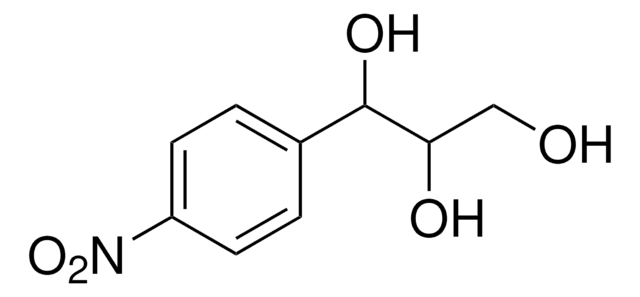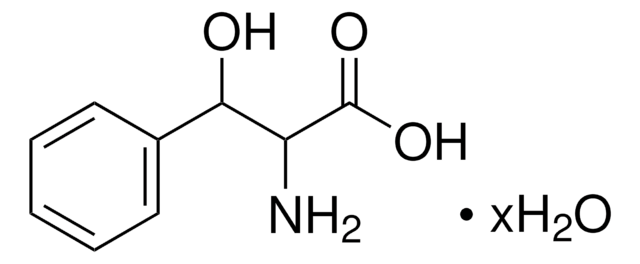D9446
L-DOPS
≥98% (HPLC)
Synonym(s):
Droxidopa, L-threo 3,4-Dihydroxyphenylserine
About This Item
Recommended Products
Assay
≥98% (HPLC)
form
powder
storage condition
desiccated
color
white to tan
solubility
DMSO: ≥3 mg/mL
storage temp.
−20°C
SMILES string
N[C@@H]([C@H](O)c1ccc(O)c(O)c1)C(O)=O
InChI
1S/C9H11NO5/c10-7(9(14)15)8(13)4-1-2-5(11)6(12)3-4/h1-3,7-8,11-13H,10H2,(H,14,15)/t7-,8+/m0/s1
InChI key
QXWYKJLNLSIPIN-JGVFFNPUSA-N
Gene Information
human ... ADRA1A(148) , ADRA1B(147) , ADRA1D(146) , ADRA2A(150) , ADRA2B(151) , ADRA2C(152) , ADRB1(153) , ADRB2(154) , ADRB3(155)
General description
Application
Biochem/physiol Actions
Features and Benefits
Signal Word
Warning
Hazard Statements
Precautionary Statements
Hazard Classifications
Eye Irrit. 2 - Skin Irrit. 2 - STOT SE 3
Target Organs
Respiratory system
Storage Class Code
11 - Combustible Solids
WGK
WGK 3
Flash Point(F)
Not applicable
Flash Point(C)
Not applicable
Certificates of Analysis (COA)
Search for Certificates of Analysis (COA) by entering the products Lot/Batch Number. Lot and Batch Numbers can be found on a product’s label following the words ‘Lot’ or ‘Batch’.
Already Own This Product?
Find documentation for the products that you have recently purchased in the Document Library.
Customers Also Viewed
Articles
Dopamine-β-hydroxylase is located inside amine storage vesicles of norepinephrine neurons. Dopamine is actively transported from the cytoplasm into the vesicles. As the enzyme is a copper containing protein, its activity can be inhibited by copper chelating agents, such as diethyldithiocarbamate and FLA-63. Inhibition of the enzyme effectively reduces tissue norepinephrine levels.
Dopamine-β-hydroxylase is located inside amine storage vesicles of norepinephrine neurons. Dopamine is actively transported from the cytoplasm into the vesicles. As the enzyme is a copper containing protein, its activity can be inhibited by copper chelating agents, such as diethyldithiocarbamate and FLA-63. Inhibition of the enzyme effectively reduces tissue norepinephrine levels.
Dopamine-β-hydroxylase is located inside amine storage vesicles of norepinephrine neurons. Dopamine is actively transported from the cytoplasm into the vesicles. As the enzyme is a copper containing protein, its activity can be inhibited by copper chelating agents, such as diethyldithiocarbamate and FLA-63. Inhibition of the enzyme effectively reduces tissue norepinephrine levels.
Dopamine-β-hydroxylase is located inside amine storage vesicles of norepinephrine neurons. Dopamine is actively transported from the cytoplasm into the vesicles. As the enzyme is a copper containing protein, its activity can be inhibited by copper chelating agents, such as diethyldithiocarbamate and FLA-63. Inhibition of the enzyme effectively reduces tissue norepinephrine levels.
Our team of scientists has experience in all areas of research including Life Science, Material Science, Chemical Synthesis, Chromatography, Analytical and many others.
Contact Technical Service












